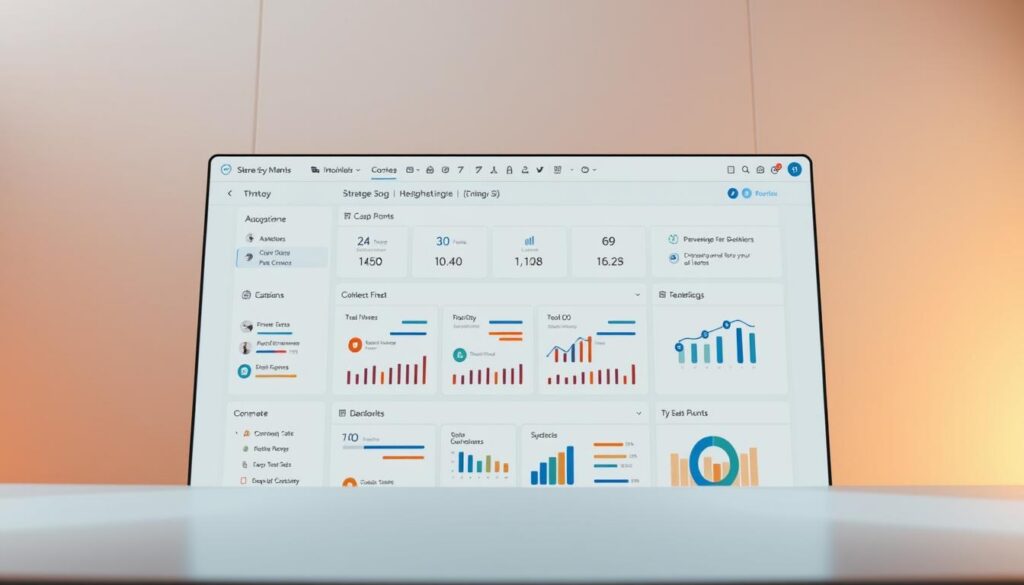In today’s fast-changing business world, having an automated go-to-market strategy is key. Businesses aiming to introduce products and enter new markets quickly need this. This guide highlights the importance of automating your go-to-market strategy.
By using automation tools, companies can make their operations smoother. They can also get better at reaching their market goals and launching products easily. We’ll share the steps and team roles needed for an effective automated strategy.
Key Takeaways
- Automated go-to-market strategy development enhances efficiency.
- Go-to-market automation tools can significantly streamline processes.
- Effective digital strategy planning is vital for successful product launches.
- A structured approach improves market effectiveness and team collaboration.
- Understanding the various stages of product launches is essential for success.
Understanding Automated Go-to-Market Strategies
An automated go-to-market strategy simplifies how products or services reach the right people. It uses technology to make things easier and more effective. A market strategy tool helps make sure messages hit the mark, place products correctly, and reach out at the best time.
Definition and Importance
This approach uses tech to cut down on manual marketing work. Knowing why it matters helps businesses stand out among competitors. It lets companies stay consistent and emphasize their main goals, improving how they connect with customers.
Key Components
Important parts of an automated go-to-market strategy include:
- Market research
- Customer profiles
- Positioning and messaging
- Pricing strategies
- Distribution methods
These elements help make marketing efforts more effective. They allow teams to make better decisions using automated marketing insights.
Benefits of Automation
Automating this process brings many pluses:
- Faster time to market
- Lower risk of failure
- Better use of resources and focus on main tasks
These perks let companies use their resources well and embrace automation. With a market strategy tool, firms are ready for steady growth and can adjust to changes in the market.
Choosing the Right Automation Tools
It’s key to choose the right automation tools for a strong go-to-market approach. These tools boost how well your operations run and greatly affect your business’s growth. The market has many options, each with special features for different business needs.
Popular Tools on the Market
Key players include HubSpot, Marketo, and Salesforce. These platforms have great software for planning strategies, especially in marketing and sales. HubSpot is top-notch for managing customer relationships and inbound marketing. Marketo shines with its email and lead nurturing features. Salesforce is best for automating sales tasks, which many companies prefer.
Factors to Consider
When picking automation tools, think about how well they work with what you already have, if they can grow with your business, their ease of use, and the support they offer. These points affect how well the tools can help with your business’s automated growth. Making sure they fit smoothly means less trouble when switching to new systems.
Cost vs. Value Analysis
It’s important to weigh the cost against the benefits before making a choice. Don’t just look at the price tag; consider how much value they’ll bring over time. The right software saves money and boosts your place in the market. Thinking about both costs and benefits helps you pick something that meets your business goals.

Designing Your Automated Go-to-Market Process
Creating an automated go-to-market plan needs careful planning and action. With a methodical plan, businesses boost their digital strategy planning and react better to the market. They must follow certain steps to make a strategy that meets market needs and reaches potential customers successfully.
Steps in the Development Process
First, research well to know your audience and what they like. Businesses need to craft messages that talk to these audiences, thinking about both demographic and psychographic parts. Also, using AI-driven strategy development makes operations smoother and gives data to fine-tune your plan.
Sales planning must match what customers expect and be flexible with market changes.
Mapping Customer Journeys
Making a visual map of customer journeys is key to a personalized experience. Mapping interactions at every step lets businesses find engagement chances and meet customer needs better. This method boosts market adaptability, letting companies tweak strategies with fresh insights and stay relevant as markets shift quickly.
Setting Clear Goals
Setting clear goals that match the company’s bigger aims is crucial for a unified automated go-to-market plan. Having specific, measurable, attainable, relevant, and time-bound (SMART) goals means everyone knows their part in success. Automation tools help sync efforts, focusing on these goals while adjusting to market changes.
Implementing the Strategy
To successfully roll out an automated go-to-market strategy, follow effective steps. Start with a systematic plan that includes testing and flexible rollouts. This helps understand how the market reacts. Make sure each step of the automation is carefully examined for best performance and alignment with the market.
Best Practices for Rollout
A good rollout for go-to-market automation needs a clear plan. Important steps are:
- Conducting beta tests to gather real-time data.
- Utilizing feedback from early adopters to enhance product features.
- Establishing measurable goals for each implementation stage.
- Maintaining open channels of communication across teams for collaborative improvement.
Training Your Team
Teaching your team about new tools is key to automation success. Workshops and practical sessions help staff master automated marketing insights. Focus areas in training should be:
- Understanding the functionality of automation tools.
- Best practices for leveraging data analytics.
- Strategies for continuous learning and adapting to new techs.
Monitoring Performance
To keep your automated go-to-market strategy on track, set up a strong performance monitoring system. Use specific metrics to check progress easily. Important metrics to watch include:
| Metric | Description | Purpose |
|---|---|---|
| Conversion Rate | Percentage of leads that become customers | Measure effectiveness of sales strategies |
| Customer Acquisition Cost (CAC) | Total cost of acquiring one customer | Evaluate the efficiency of marketing efforts |
| Return on Investment (ROI) | Financial return from marketing investments | Assess overall success of campaigns |

Measuring Success and ROI
When we look at how well automated go-to-market strategies work, we focus on key indicators. These show how effective our marketing efforts are and how well we keep customers interested. They help us see where we’re getting good returns on our investment (ROI) and what we need to fix.
Key Performance Indicators (KPIs)
It’s important to pick the right indicators to watch. Some of the main ones include:
- Conversion rates
- Customer acquisition costs
- Customer lifetime value
- Engagement metrics
These indicators let businesses judge how well their marketing is doing. They guide important choices.
Tools for Analysis
Using the right tools can really help understand how campaigns perform and what customers do. There are platforms that give automated insights into marketing. They make gathering and figuring out data much easier. With these tools, companies can see how things are trending and tweak their strategies without delay.
Adjusting Based on Feedback
Listening to feedback is key to getting better. Setting up ways to hear and make sense of feedback helps companies improve. Changing tactics based on what analysis tools show keeps marketing efforts sharp and effective. This is crucial in a market that’s always changing.
Future Trends in Go-to-Market Automation
The go-to-market automation scene is changing a lot. This change comes mainly from weaving AI and machine learning into big plans. These smart technologies help businesses predict trends, letting them stay ahead.
AI and Machine Learning Integration
As companies improve their strategies, using AI for growth planning is key. AI-driven insights help shape marketing to fit consumer needs better. This makes decisions smarter and campaigns more effective by using up-to-the-minute data.
Market Adaptability
Being able to adapt fast is crucial in today’s world where people want unique and quick experiences. Companies using new automation tools offer interactions that people love, increasing customer happiness. Those ready to change will succeed, growing their presence as they meet what consumers want.
Evolving Consumer Expectations
It’s vital to keep up with what consumers expect if you want to do well. Companies should be flexible, using automation to bring new ideas to life. By adding new tech smoothly, they improve customer experiences and stand out in a competitive field. For more on marketing trends, check out this relevant resource.
FAQ
What is an automated go-to-market strategy?
It’s a plan that uses automation tools. It delivers products or services to the right market. This improves how you talk to customers, and helps you find the best time to reach out.
What are the key benefits of using automation in go-to-market strategies?
Benefits include faster product launches and lowering the chance of failure. They also make sure resources are well used, and teams can focus on their main tasks.
Which automation tools are commonly used for go-to-market strategies?
HubSpot, Marketo, and Salesforce are often used. They help with managing customer relationships and bringing marketing efforts together.
How do I choose the right automation tools for my business?
Think about how easy they are to use, if they can grow with you, and how they make users feel. Also, compare costs to benefits to see if it’s a good long-term choice.
What are the steps involved in designing an automated go-to-market process?
First, do your research and know your audience. Then, decide what you want to say and how you’ll sell it. Map out how customers will see and experience your brand at every step.
What best practices should I follow during the implementation of an automated strategy?
Make sure to test in steps, use a phase-in approach, and teach your team how it works. Always check your progress to stay relevant in the market.
How can I measure the success of my automated go-to-market strategy?
Look at key indicators like how many customers you’re getting and what it costs. Using smart analytics helps you understand your campaign better and shows the value of your investment.
What future trends should I be aware of in go-to-market automation?
Watch for AI and machine learning which make smarter decisions possible. Also, businesses are now focusing more on quick, personalized responses to what customers want.



